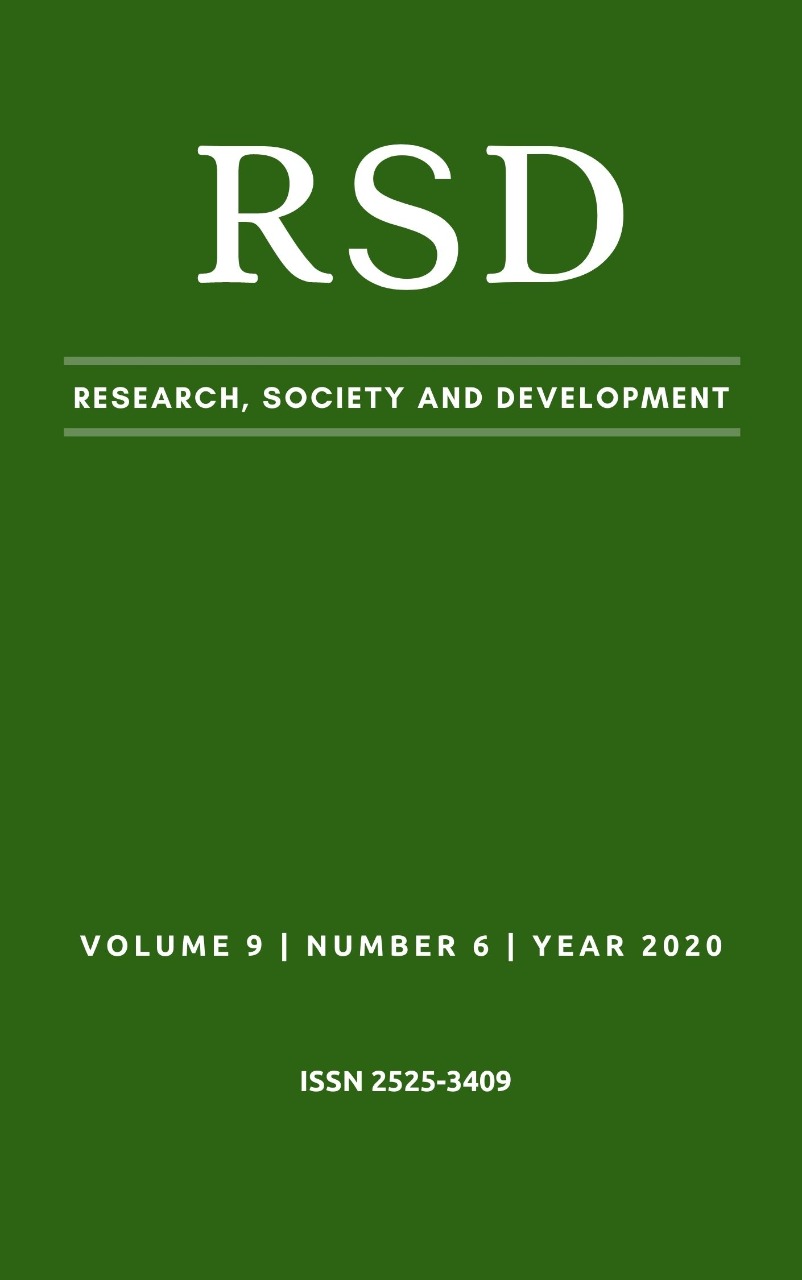Resposta terapêutica da cisteamina no tratamento do melasma
DOI:
https://doi.org/10.33448/rsd-v9i6.3468Palavras-chave:
Melasma, Hipermelanose, Cisteamina.Resumo
O objetivo deste estudo foi avaliar de que forma o uso da cisteamina no tratamento do melasma vem sendo trabalhado na literatura. Trata-se de uma pesquisa qualitativa do tipo revisão integrativa para identificação de produções sobre temas associados ao tratamento tópico do melasma com a cisteamina. A busca dos artigos foi através das bases de dados Scopus, Science Direct e Pubmed com a utilização dos termos: “melasma” e “cysteamine” e termos correspondentes no português. A pesquisa obedeceu aos critérios de inclusão: a) artigos b) estar disponível em texto completo c) recorte temporal de 01/01/2010 à 31/03/2020 d) estudos disponíveis nos idiomas português, inglês ou espanhol. Como critérios de exclusão, foram desconsiderados os textos que não tinham relação com a temática ou apresentaram duplicatas. Do montante de 11 artigos apresentados, 6 foram selecionados por afinidade à temática de busca, sendo 5 artigos excluídos pelos critérios supracitados. A resposta terapêutica da cisteamina para o tratamento do melasma é positiva, reduzindo as lesões hiperpigmentadas e com efeitos adversos controláveis com a duração do tratamento. Não foram encontradas evidências do uso da cisteamina associada a outros ativos ou procedimentos dermatológicos.
Referências
Agostinho, G. L. P. L., Oliveira, R. T. G. de, Urzedo, A. P. da S., Cunha, M. G. da, & Machado Filho, C. D. S. (2018). Avaliação comparativa do tratamento de melasma com microagulhamento associado ou não ao drug delivery. Surgical & Cosmetic Dermatology, 10(3), 216–220.
Alster, T. S., & Graham, P. M. (2018). Microneedling: A review and practical guide. Dermatologic Surgery, 44(3), 397–404.
Atallah, C., Charcosset, C., & Greige-Gerges, H. (2020). Challenges for cysteamine stabilization, quantification, and biological effects improvement. Journal of Pharmaceutical Analysis.
Austin, E., Nguyen, J. K., & Jagdeo, J. (2019). Topical Treatments for Melasma: A Systematic Review of Randomized Controlled Trials. Journal of Drugs in Dermatology, 18(2), 1156–1171.
Braghiroli, C. S., & Conrado, L. A. (2018). Microagulhamento e distribuição transepidérmica de drogas. Surgical & Cosmetic Dermatology, 10(4), 289–297.
Diosti, G. de M., Mulinari-Brenner, F., Neto, J. F., Werner, B., do Nascimento, A., & Piva, F. M. (2012). Avaliação clínica e histológica de pacientes com melasma refratário tratadas com laser de érbio: Yag fracionado. Surgical and Cosmetic Dermatology, 4(1), 114–120.
Farshi, S., Mansouri, P., & Kasraee, B. (2018). Efficacy of cysteamine cream in the treatment of epidermal melasma, evaluating by Dermacatch as a new measurement method: a randomized double blind placebo controlled study. Journal of Dermatological Treatment, 29(2), 182–189.
Grimes, P. E., Ijaz, S., Nashawati, R., & Kwak, D. (2019). New oral and topical approaches for the treatment of melasma. International Journal of Women’s Dermatology, 5(1), 30–36.
Kalil, C. L. P. V., Reinehr, C. P. H., & Milman, L. de M. (2017). Luz Intensa Pulsada: Revisão das indicações clínicas. Surgical and Cosmetic Dermatology, 9(1), 9–16.
Kasraee, B., Mansouri, P., & Farshi, S. (2019). Significant therapeutic response to cysteamine cream in a melasma patient resistant to Kligman’s formula. Journal of Cosmetic Dermatology, 18(1), 293–295.
Lima, E. D. A. (2015). Microagulhamento em melasma facial recalcitrante: uma série de 22 casos *. Anais Brasileiros de Dermatologia, 90(6), 917–919.
Mansouri, P., Farshi, S., Hashemi, Z., & Kasraee, B. (2015). Evaluation of the efficacy of cysteamine 5% cream in the treatment of epidermal melasma: A randomized double-blind placebo-controlled trial. British Journal of Dermatology, 173(1), 209–217.
McKesey, J., Tovar-Garza, A., & Pandya, A. G. (2019). Melasma Treatment: An Evidence-Based Review. American Journal of Clinical Dermatology.
Miot, L. D. B., Miot, H. A., Da Silva, M. G., & Marques, M. E. A. (2009). Fisiopatologia do melasma. Anais Brasileiros de Dermatologia, 84(6), 623–635.
Ni, Z., Mu, Y., & Gulati, O. (2002). Treatment of melasma with Pycnogenol®. Phytotherapy Research, 16(6), 567–571.
Pereira, A. S., Shitsuka, D. M., Parreira, F. J., & Shitsuka, R. (2018). Metodologia da Pesquisa Científica. [e-book]. Ed. UAB/NTE/UFSM. Santa Maria/RS. Disponível em:
http://repositorio.ufsm.br/bitstream/handle/1/15824/Lic_Computacao_Metodologia-PesquisaCientifica.pdf?sequence=1. Acesso em: 05 Abril 2020.
Pinto, C. A. S., Delfes, M. F. Z., Reis, L. M. dos, Garbers, L. E., Passos, P. C. V. da R., & Torre, D. S. de. (2015). Uso do pycnogenol no tratamento do melasma. Surgical & Cosmetic Dermatology, 7(3), 218–222.
Souza, M. T. de, Silva, M. D. da, & Carvalho, R. de. (2010). Revisão integrativa: o que é e como fazer. Einstein, 8(1), 102–106.
Spadafora, M. C. F. de A., Pereira, Ma. D., Leite, R. S., Yoshida, E. H., & Santos, N. S. dos. (2019). Os benefícios dos despigmentantes para o tratamento do melasma e rejuvenescimento facial. Revista Saúde Em Foco, 599–608.
Steiner, D., Arantes, C., Buzzoni, B., Vinicius, T., Cunha, R., & Urano, A. (2011). Melasma e laser fracionado não ablativo ( 1540nm ): um estudo prospectivo. Surgical & Cosmetic Dermatology, 3(1), 37–40.
Steiner, D., Feola, C., Bialeski, N., & de Morais e Silva, F. A. (2009). Tratamento do melasma: Revisão sistemática. Surgical and Cosmetic Dermatology, 1(2), 87–94.
Wanick, F. B. F., Zink, B. S., & Lopes, R. F. (2011). Avaliação da eficácia do licopeno , beta- caroteno e Lactobacillus johnsonii no tratamento de manutenção do melasma durante o verão : um estudo comparativo. Surgical & Cosmetic Dermatology, 3(4), 297–301.
Downloads
Publicado
Edição
Seção
Licença
Autores que publicam nesta revista concordam com os seguintes termos:
1) Autores mantém os direitos autorais e concedem à revista o direito de primeira publicação, com o trabalho simultaneamente licenciado sob a Licença Creative Commons Attribution que permite o compartilhamento do trabalho com reconhecimento da autoria e publicação inicial nesta revista.
2) Autores têm autorização para assumir contratos adicionais separadamente, para distribuição não-exclusiva da versão do trabalho publicada nesta revista (ex.: publicar em repositório institucional ou como capítulo de livro), com reconhecimento de autoria e publicação inicial nesta revista.
3) Autores têm permissão e são estimulados a publicar e distribuir seu trabalho online (ex.: em repositórios institucionais ou na sua página pessoal) a qualquer ponto antes ou durante o processo editorial, já que isso pode gerar alterações produtivas, bem como aumentar o impacto e a citação do trabalho publicado.


